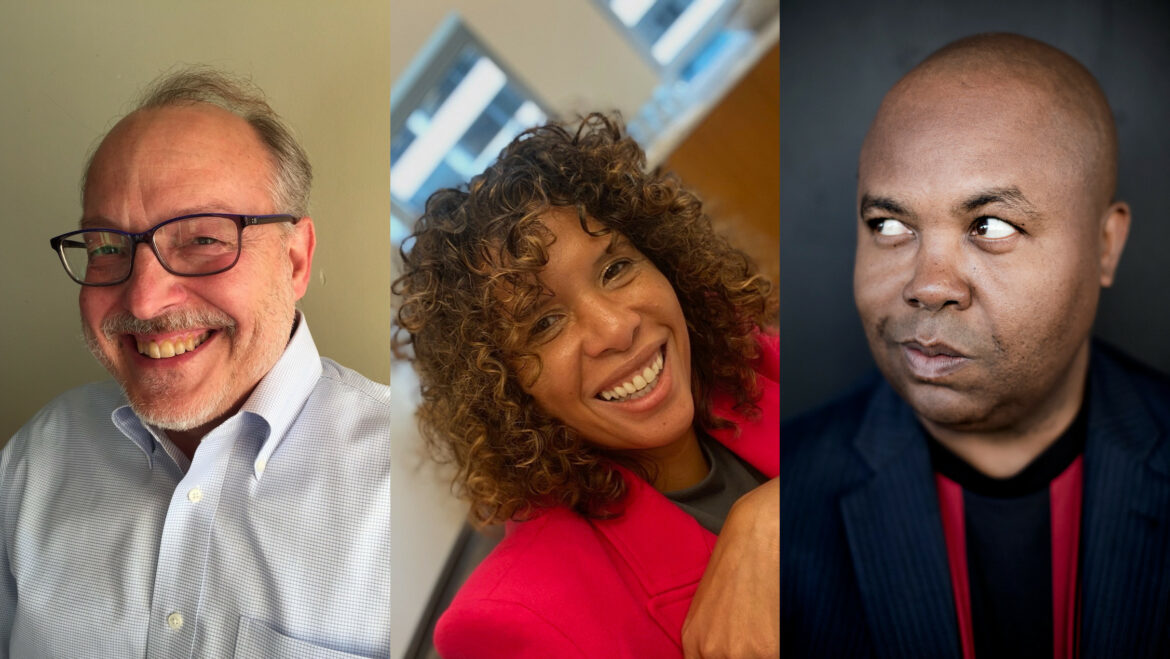These lessons in ‘hostiness’ matter more than ever for public media’s future

Glynn Washington photo: Smeeta Mahanti
John Barth, Juleyka Lantigua and Glynn Washington
One day in my last few months as a reporter at New Hampshire Public Radio, a new reporter joined our staff. She was fresh off her first job at a tiny station in the West. She was excited: For the first time, she’d have an editor who would train and challenge her.
It was to be everything she had been looking for, back when she was filing spot news, day after day, with no editor.
The day before she started, our news director left.
When this young woman realized she had enlisted as a sailor on a captainless ship, she was crestfallen.
Most reporters, producers and hosts choose public radio careers because they believe in the mission and they love the craft of broadcast journalism.
But, as Current noted in January, public radio has a talent crisis.
Clearly, that crisis stems from many sources: low pay, overwork, the constant barrage of bad news, toxic work environments, lack of inclusion. But it’s also true that a dearth of training is to blame: When young journalists are left to their own devices to learn new skills, they learn more slowly and struggle harder to succeed. It’s just one more reason to leave the profession or to leave public media for work environments where they may get the training (and respect, pay and opportunities) they were dreaming of.
As a longtime audio journalist, I have long felt that we do not provide enough training in the skills required for the kind of immersive and accountability journalism that public media, done well, excels in. This is especially true for on-air talent.
‘Hostiness’
Neither public radio nor podcasting leaders provide much — if any — training to the people behind the mic.
That’s a problem, because research in the podcast industry shows that one of the primary drivers of loyalty is the relationship listeners feel to a host. As Snap Judgment’s Glynn Washington told me, “I’m always struck when people speak to me on the street. Often, they’ll be very, very intimate. They will be telling me their deepest stories. And I think it’s because we have a relationship, even if we don’t necessarily know each other.”
Listener loyalty and fandom grows audience. More than 80% of women listeners have shared a show with friends and family, according to Edison Research’s Women’s Podcast Report (December 2022). Word of mouth is also the number one way women find new podcasts. What prompts listeners to share a program? Almost 70% of women listeners do so because they think their friends will like the host.
We’ve known this for a long time in radio, too.
The importance of high-quality hosting, coupled with the lack of attention given to host training, led me to launch the podcast Sound Judgment. The show explores what PRX long ago labeled as “hostiness” — the mysterious qualities embodied by hosts who keep listeners coming back, over and over again. I use compelling podcast or radio episodes to dissect what works. As Whisper, Speak, Roar Media’s Suzanne Schaffer, a veteran American Public Media producer, wrote recently: “[Sound Judgment] always shows, doesn’t tell. You can hear in the audio examples how someone elevated a good story to an unforgettable one.”
What can we learn through dissecting an episode with the show’s host or producer?* We can try to uncover what it takes now — in this tumultuous cultural and political moment — to create and deliver stories with impact, and to produce noteworthy programs that listeners gravitate to and share (and that also, ultimately, attract funding).
What does it take to become a beloved host?
Three of my podcast guests offer lessons in hostiness that are especially applicable to public media talent: Snap Judgment’s Glynn Washington; Juleyka Lantigua, an NPR alum whose LWC Studios produces podcasts and films for Latino audiences; and former PRX CCO John Barth, Marketplace’s founding producer and one of public media’s best-known talent scouts.
A few of the perspectives I’ve gleaned from them illuminate the kinds of strategic thinking (and thus, training and development) that, if we invest in them, will help public media leaders develop, launch and maintain more standout shows over time. From Glynn Washington, the role of an animating force; from John Barth, developing a sound vision; and from Juleyka Lantigua, the importance of cultural competence.
The animating force behind ‘Snap Judgment‘
Snap Judgment exists because in 2007, Glynn Washington heard about PRX’s Talent Quest to find radio’s next great host. “Hostiness, hostiness, we’re looking for hostiness,” Washington exclaims. “I think maybe I got some hostiness.” After several rounds of competition, he and his co-EP, Mark Ristich, would work overnight to create a prototype. Washington had held many jobs, including educator, diplomat and nonprofit leader. He’d even run for mayor of Oakland, Calif. He had no radio experience. But, he says, “I could tell a story.”
Of course, Washington was one of the winners of that talent quest. He and Ristich would launch Snap Judgment in 2010. Thirteen years later, Snap is heard on more than 500 stations in the U.S. and Canada.
What is it that gives Snap such staying power? On Sound Judgment, we explored some answers by dissecting “Zoo Nebraska,” a dark tale of a chimp researcher turned reluctant zookeeper.
Perhaps most important is the animating force that drives a creator to birth a show. In Washington’s case, that’s empathy. “I want to get you to walk in someone else’s shoes for a while,” he says. That may sound pat, but clarifying the animating force driving a radio show, podcast or story provides a framework for most of the editorial choices that follow, including hiring and training. (It may be obvious, but an animating force is context-driven: One show’s reason for existence is different from another’s.)
When it comes to hiring with an animating force in mind, consider the challenge facing Washington and Ristich. They hire and grow producers who understand that reporting pieces through this lens strays from the way most journalists pursue their work. “I want this to be as accurate as anything you hear in any news story,” Washington says. And, he adds, “I want to hear what you feel.”
Threading this needle isn’t easy, he acknowledges. “We’re asking people to open themselves up,” he says. “No one wants to do that. You will recoil from opening up your emotional world, especially to have millions of people comment on it.”
The result — evident in “Zoo Nebraska” — is a depiction of the humanity of Snap characters. “Very rarely is someone a purposeful villain,” Washington says. “Generally, even if we think we did wrong, we have reasons why we did wrong. And that makes it complicated. It makes it real. There are going to be very, very few cartoon bad guys on Snap Judgment.”
It is, in part, the portrayal of fully realized characters, and exploring how they change, that makes Snap stories so demanding of a listener’s full attention — and of a journalist’s. Producing and hosting such stories may be difficult — and, for many audio storytellers, fulfilling. The task also requires continuous learning and feedback.
Washington remains up for the challenge of developing a cadre of producers capable of scrupulous accuracy and emotional transparency. In fact, he considers it one of the most vital parts of his and Ristich’s jobs. “I think our biggest strength is recognizing and developing talent,” he says.
Is your sound vision clear?
“We used to talk about hostiness all the time!” John Barth wrote to me when he heard about my forthcoming project. Like Glynn Washington, I thought, “Hostiness?! What is hostiness?”
Barth laughs at the difficulty of defining just what PRX was looking for. “We’re always looking for the blue M&M,” he says. “There’s this range of curiosity and joy and versatility that comes across when you encounter hostiness. It’s that compelling nature that if you saw them live on stage, you’d never want the show to end.”
The holy grail, of course, is to field a show whose host becomes a star: That’s why Ira Glass, Terry Gross, Glynn Washington and Jad Abumrad consistently come up as the OGs of hostiness.
Barth is quick to note that hiring and developing those “blue M&Ms” doesn’t happen in a vacuum: One first needs to have a vision for the sound of the show. As a young producer developing Marketplace, he says, there was an editorial vision, a concept for sharing stories about the economy in new ways. And he had a sound vision. “It needed to be distinctive,” he says. “I always imagined how the audience was listening to the show and the kind of listener I wanted to attract. That had to be a certain sound.”
The next step: finding a host whose style matched and expanded upon his vision. “When you’re hiring a host, the host really does imprint their own sound, voice, and style on the show,” Barth says. “So it actually begins to define the brand that you’re creating.”
The crucial roles of inclusivity and belonging
These governing values — an animating force and a sound vision — are both shaped by and shape the need for cultural competence, which is worth considering as the third leg of an audio storytelling stool in 2023. It’s evident in the tiny, telling details that make or break “authenticity” for an audience. One example surfaced when LWC Studios CEO and How to Talk to [Mamí & Papí] About Anything host Juleyka Lantigua and I dissected an episode.
The show, designed to serve a millennial, first-generation Latina listener, attempts to help guests navigate tricky intergenerational conflicts with their immigrant parents. In the episode we explored, a young Latina shares her depression with her mother. Lantigua asks a guest, an expert in Latina resilience, how the woman can do something even harder than that confession: admit to taking antidepressants. “How can a first-gen prepare to have that conversation with their parents so that their parent doesn’t immediately go, ‘Oh, my God, something’s really, really wrong with my kid?’” she asks. Communicating about mental health treatment isn’t an obstacle in every culture, but it is for many Latino families. It’s that kind of thing, Lantigua says, that’s best handled by a producer or host with a shared cultural framework.
Like an animating force, the depth of lived experience — cultural competence — necessarily differs from show to show. “Because [Mamí & Papí] is about the generational communication gap between immigrants and their first-gen kids,” Lantigua says, she hires for cultural competence. “On this show, you have to have the relevant experience, because otherwise you won’t be able to pick the right stories or the right experts.”
In the end, the question becomes whether we take seriously enough the relationship among hosts and their teams, and listeners. We know listeners crave high-quality content delivered by credible, relatable, distinctive hosts. As public media struggles with declining funding, layoffs and questions about how to best serve changing communities, one of the ways out is to invest in quality. Yes, audiences are fragmented and budgets challenged. But within those realities, when we have the will and the innovation to develop and mentor the next generation of hosts, producers and editors, audiences will grow.
* The legendary instructor Rob Rosenthal pioneered dissection as a superb form of audio instruction years ago, with his PRX/Transom show HowSound, now titled Sound School. ^
Elaine Appleton Grant is EP and host of Sound Judgment and CEO of Podcast Allies, a production, consulting and training firm serving public media, nonprofits and higher education leaders.






